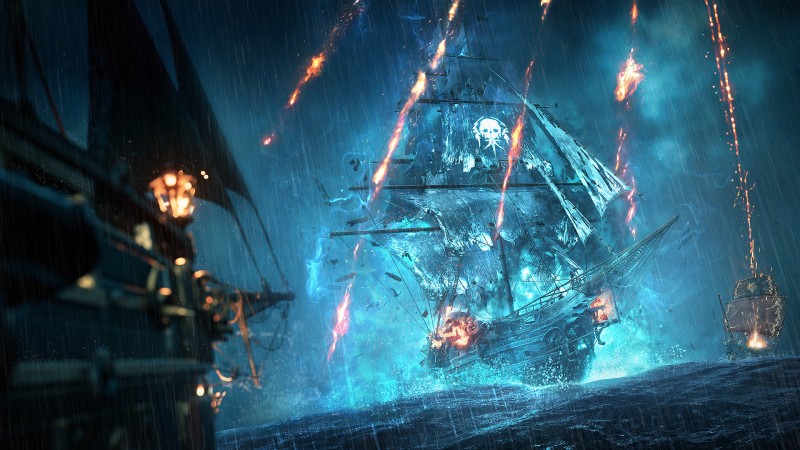Skull and Bones Review – Middle High Sea

Like a ship that has changed tack countless times and delayed its arrival at port, Skull and Bones has launched far later than expected and faced trouble along the way. Even so, this pirate adventure surprised me with the breadth of its world, the richness of its commerce simulation, and an approachable and rewarding naval combat system. As a living game built around seasonal content and a growing universe, it has a ways to go to be at its best, but the bones of a quality experience are here.
You are a treasure-hungry pirate eager for infamy as you set out across the Indian Ocean, tracking down treasure chests, plundering seaside towns, and, most prominently, battling other ships on the high seas. On-foot activity is reserved for social spaces and the most minimal of story development – the entirety of action unfolds on the water, where you develop an impressive array of ships and weaponry through your ill-gotten gains.
Launching where the maritime voyages of the Assassin’s Creed games left off, I enjoyed the deliberate pacing of sea exploration and movement, punctuated by the regular interruption of cannon fire and mortars. Especially in the early hours, I was often transfixed by the sights and sounds of moving across the water, listening to my crew’s sea shanties, watching for breaching whales, and using my spyglass to spot distant shipwrecks. It’s a big and beautifully crafted world of island-rich open waters and tricky narrow riverways.
Combat has just enough complexity to remain entertaining as you balance turning speed, facing, and aiming to maximize damage output while dodging or bracing against the worst attacks of your opponents. The real fun comes from building and tweaking your boat as an engine of destruction; the variety of ship builds and approaches to fighting kept me consistently interested in chasing that next upgrade. I appreciated the approach to tracking specific items and upgrades, with clear markings on the map for where to find what you want. Because of that, it becomes about whether you have enough money to buy something or a powerful enough ship to take it.
The bulk of play is PvE encounters against privateers, merchants, and corporation ships, played either solo or cooperatively. Even if the open servers allow for both structured and informal PvP, my anecdotal experience was that most players were focused on their own adventures. If they joined a battle, it was often to help out. Your mileage may vary, but I liked the mix of mostly campaign-style progression with the option to connect with other players when I wanted.
[embedded content]
Beyond ramming and blowing up other ships, Skull and Bones’ other core pillar is commerce. Ubisoft has built a robust trading system, the most lucrative of which involves illicit rum and opium shipments. I appreciated how the game allows players to choose how much they want to engage here. The selling of commodities gathered from sunken ships is the most superficial layer, but you can also run your own manufacturing and delivery contracts for higher sums. And as you round the corner into the endgame, an entire kingpin empire opens up, letting you take over lumberyards and other factories to generate income passively.
The pirate life eventually wears out its welcome; many of the game’s most significant problems only arise after many hours of play. While it’s fun in the early hours getting your bearings in an unfamiliar sea, later side and main missions become painfully repetitive. Long ocean voyages start to lose their charm, and a fast travel system that only works from port feels increasingly restrictive since you’re often eager to return to a mission giver to keep the action moving.
The freeform progression that was so welcome in the early hours also causes problems over time, as it’s too easy to be over- or under-leveled for certain content you might wish to confront, robbing many encounters of tension since the winning party is so evident from the outset.
The storytelling is incredibly sparse, led by very few core contacts, all of whose arcs are pretty one-note. And while it’s nice that you can customize the look of your pirate captain, their voiceless absence of personality feels especially ill-suited to the big personalities you expect in a classic pirate tale.
Nonetheless, the combination of building a commerce empire, sea monster hunts, engaging in late-game PvE and PvP events, and the chance to continue tweaking and building your ideal pirate ship has appeal even after the core story missions wrap up, giving me hope that longterm endgame could be entertaining. And while it’s early days, I saw potential in the larger ship team-up activities I tried out, where each ship takes on specific roles like you might see in an MMO.
Despite its long and circuitous course to arrive at port, Skull and Bones is the type of game that may change significantly in the coming months. But to evaluate it as it stands, fellow pirate enthusiasts may discover what I did – a flawed but beautifully presented historical fantasy in which one can take to the water and make a fortune, even if absolutely everything about the pirate life isn’t always pretty.


Comments are closed.